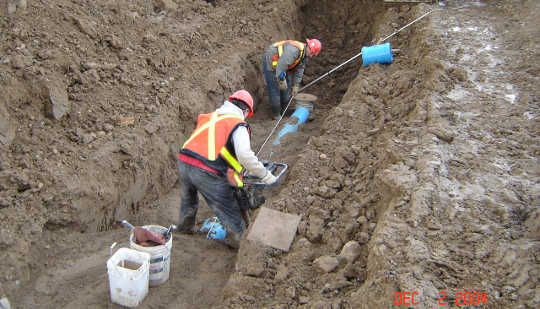
The calls and e-mails arrive as often as several times a week from people with concerns about drinking water. Some of the callers — who include homeowners, architects and builders — want to know why their water smells like gasoline. Others want to know which kinds of pipes to install to minimize risks of exposure to hazardous chemicals.
Purdue University environmental engineer Andrew Whelton has spent more than a decade studying how pipes that carry drinking water to our homes, schools and business places can affect water quality and health. But still, he struggles to answer their questions, particularly when it comes to a new generation of plastic piping material called cross-linked polyethylene, or PEX. Used in more than 60 percent of new construction projects in the United States — according to the Plastics Pipe Institute, the pipe industry’s major trade association — the flexible tubing is appealingly cheap and easy to install. But data are still accumulating on how it affects the water that flows through it, Whelton says, and certification standards may be failing to test for compounds that affect water quality. That leaves consumers in the dark.
The latest research out of Whelton’s lab has revealed a variety of compounds that can escape from PEX pipes, potentially causing drinking water to smell or taste bad. His group is also finding significant variations in what leaches out of PEX pipes, not just across brands but also among products of the same brand, and even from batch to batch of the same product — a confounding list of unknowns and potential concerns that makes it complicated to give advice to consumers who want safe plumbing materials.
“There have been marketing campaigns that imply we understand the safety of these products. In fact, we do not.” – Andrew WheltonThe plastic pipe industry stands by the rigorous system of plumbing codes and certification standards that determine which pipes can be used in construction. But even as the water crisis in Flint, Michigan, has drawn attention to the hazards of lead pipes, few independent researchers other than Whelton and his colleagues are studying the implications of PEX in the United States.
“I am a homeowner who has had to replumb his house before, and I am frustrated about the way things are,” says Whelton. “We don’t have information about the chemicals that are leaching out of these pipes, and because of that, we can’t make the decisions we want to make.”
“There have been marketing campaigns that imply we understand the safety of these products,” he adds. “In fact, we do not.”
Unsettling Unknowns
By now, anyone who has fretted about the health and environmental complexities of plastic has found ways to limit its presence in their lives — by switching to stainless steel water bottles, buying canned foods made with BPA-free linings or toting ceramic coffee cups. But plastic pipes have lurked under many people’s radar, even as they have become an increasingly popular alternative to copper for delivering drinking water into homes and buildings.
Although copper remains common inside buildings, there are compelling reasons why new projects frequently use PEX. Price is one major draw: PEX can be a good 75 percent cheaper than copper. In one 2013 survey of plumbing supply stores in southern Alabama, copper cost US$2.55 per foot compared with 48 cents per foot of PEX. That can add up to thousands of saved dollars over the course of a house project.
PEX is also lightweight, flexible, easy to transport and install, and built to be long lasting. Like copper, it can carry hot water without melting. There may even be environmental benefits: production, use and disposal of PEX products uses far less energy ands produce less carbon dioxide than copper. As part of its Leadership in Energy and Environmental Design — LEED — rating system, the U.S. Green Building Council offers design credit for PEX piping, which overcomes some of copper’s other flaws, too — including the potential for corrosion and related health risks, such as liver damage and kidney disease.
PEX is also tested rigorously before it can be certified to comply with plumbing codes, says Lance MacNevin, director of engineering in PPI’s Building & Construction and Conduit divisions. Embedded in those codes, MacNevin says, are requirements that piping meet certain standards set by the global standards organization ASTM International. And within the ASTM standards are yet more standards set by NSF International, an independent non-governmental public health and safety organization that creates specifications for pipes made to carry drinking water.
NSF has tested some 1,700 types of chemicals and compounds in water that comes into contact with plumbing components and set a standard called NSF/ANSI 61 to make sure they are below levels that would cause health concerns set by the U.S. Environmental Protection Agency or Health Canada, says Dave Purkiss, general manager of plumbing products at NSF International. Plumbers and plumbing inspectors are trained to understand the codes, MacNevin adds. And third-party certification involves stringent quality control, random plant inspections and annual monitoring.
“The existing system of codes, standards and certifications is extremely rigorous,” MacNevin says. “Our position is that plastic is the preferred solution over all other materials.”
Whelton’s research, though, has flagged some unsettling unknowns about PEX pipes, starting with the lack of publicly available information about what is actually in them — with a wide variety of possibilities. PEX can come in one of three categories, called PEX-a, PEX-b and PEX-c. In some applications it’s layered with metals such as aluminum. Overall, consumers can choose from at least 70 different brands that have been certified by NSF/ANSI 61.
So far, studies in Europe and the U.S. have revealed at least 158 contaminants in water that has been associated with PEX, and scientists are still trying to get a handle on where they all come from and how they might affect people. As part of one ongoing effort, an open-data project called Quartz has analyzed patents, safety data sheets and other sources to document about a dozen general components, solvents and other substances in PEX, some that could be hazardous at high enough levels, though the doses actually reaching people still need to be evaluated. MacNevin says it would take extraordinarily high exposures — much higher than someone could get from a pipe — to reach those hazardous levels, and some of the data used in Quartz also appeared to come from companies that don’t make PEX water pipes. Other recent research out of Whelton’s lab, adds Purkiss, has revealed contaminants at levels far lower than NSF standards.
Possible health implications are particularly hard to pin down because different types of PEX leach different materials.“We’re just trying to map what the substances are that can be the causes of what [Whelton] is finding in water,” says James Vallette, research director at Healthy Building Network, an organization focused on reducing the use of hazardous chemicals in building materials, which is collaborating on the Quartz project. “We’re not willing to make health statements.”
Possible health implications are particularly hard to pin down because different types of PEX leach different materials, and, without routine disclosure of ingredients hidden within trade secrets or of specific NSF testing results, it is impossible for consumers to know what they’re getting. In a study published this spring in the Journal of the American Water Works Association, Whelton and colleagues tested eight varieties of PEX over 28 days and found extensive variability in the kinds of chemicals that came out of each. Three of the eight released enough of a measure called assimilable organic carbon to exceed the levels needed for harmful microbes to grow inside pipes.
The study also found evidence that still-unidentified chemicals may be contributing to odors associated with PEX pipes, along with compounds called ETBE and MTBE that have been identified in previous work. And those smells can make water unpalatable. An analysis reported in 2014 by Whelton’s group found odor levels that exceeded EPA limits in water that flowed through six brands of PEX. Those odors were not there before the water went through the pipes.
Many questions about PEX remain unanswered, agrees Andrea Dietrich, an environmental engineer and water-quality expert at Virginia Tech in Blacksburg. Does water need to be treated differently before traveling through plastic pipes than before flowing through copper? And should protocol vary depending on a region’s geology, which can alter water’s mineral content and subsequent reactivity? “Those factors haven’t been explored,” she says. “I just don’t think the long-term data are out on PEX pipes.”
Information, Please
Adding to the complexity of evaluating PEX, performance also seems to depend on how, when and where the pipes are used. In a study published last year, Whelton’s team found that a cleaning method used on newly installed PEX pipes alters resulting chemical levels and odors in water. And those results can change over time. In data Whelton will present at the AWWA conference in June, Whelton’s team analyzed two brands of PEX for two years after installation. They found few changes in one brand, but there was a lot more leaching out of the other by the end of the study than at the beginning.
And while current NSF/ANSI standards are extremely valuable, Whelton would like the guidelines to specify more chemicals, including some that make water smell bad enough to be undrinkable (even if they still meet health standards) and others that could allow illness-causing bacteria to flourish. He’d also like to see routine testing for chemicals at more than one point in time. Drinking-water standards in the U.S. cover only the quality of the water, not performance of the material, he adds, and there is no federal system to issue recalls or safety alerts.
Compliance with standards also doesn’t guarantee that pipes are safe, and history has made it clear that pipe choices can be catastrophic. That history includes a major class action lawsuit over polybutylene pipes, a type of plastic used in residential and commercial projects for nearly two decades before finally getting linked to high rates of failure and catastrophic leaks in the 1990s. “I want to make it clear that we are not against the industry,” Whelton says. He just wants to make more information available to consumers.
Water is generally safe in the United States, Dietrich adds, and she usually drinks from the tap wherever she goes, even when it emits certain benign smells. But she’s frustrated by a system that makes it easy for new products to slip into the market without extensive analyses. “We’re not proactive about protecting drinking water, and that includes rigorously testing materials used in plumbing,” she says. “The consumer ends up being the beta tester.”
Better advice may be coming soon. When his new results come out this summer, Whelton hopes to be able to give homeowners more details about plumbing safety and specific products. “We’re heavy into getting data,” he says. “Once we get all the data, we’re going to turn and do educational efforts.”
This article originally appeared on Ensia ![]()
About The Author
 Emily Sohn is a freelance journalist in Minneapolis whose stories have appeared in the Los Angeles Times, Discovery News, Smithsonian, Health, Backpacker, Science News, U.S. News & World Report, Minnesota Monthly and other publications.
Emily Sohn is a freelance journalist in Minneapolis whose stories have appeared in the Los Angeles Times, Discovery News, Smithsonian, Health, Backpacker, Science News, U.S. News & World Report, Minnesota Monthly and other publications.
Related Book:
at

Thanks for visiting InnerSelf.com, where there are 20,000+ life-altering articles promoting "New Attitudes and New Possibilities." All articles are translated into 30+ languages. Subscribe to InnerSelf Magazine, published weekly, and Marie T Russell's Daily Inspiration. InnerSelf Magazine has been published since 1985.

Thanks for visiting InnerSelf.com, where there are 20,000+ life-altering articles promoting "New Attitudes and New Possibilities." All articles are translated into 30+ languages. Subscribe to InnerSelf Magazine, published weekly, and Marie T Russell's Daily Inspiration. InnerSelf Magazine has been published since 1985.
























